The Unfinity Gauntlet, Part 2
Last week, I started telling card-by-card design stories about Unfinity. Today, I continue with more stories.
Astroquarium

One of our goals when working on stickers was trying to find different ways to use them. Yes, you could change the nature of a card, but could we make individual cards that cared about stickers in different ways beyond that? This led to the team, spearheaded by Chris (Mooney, my strong second and right-hand person), to make a bunch of cards that had some element of the art that you interacted with. Astroquarium was a card that cared about sticker size. It wanted players to use the biggest stickers they could. (Juggletron did the opposite, encouraging players to use the smallest stickers possible.) The flavor from the beginning was that this was a tank of water that had cracks in the glass and that you had to use your stickers to keep the water from getting out. If you did, you got a bonus. To playtest these cards, Chris drew sketches and had those sketches put into our database so that they would appear on the playtest cards.
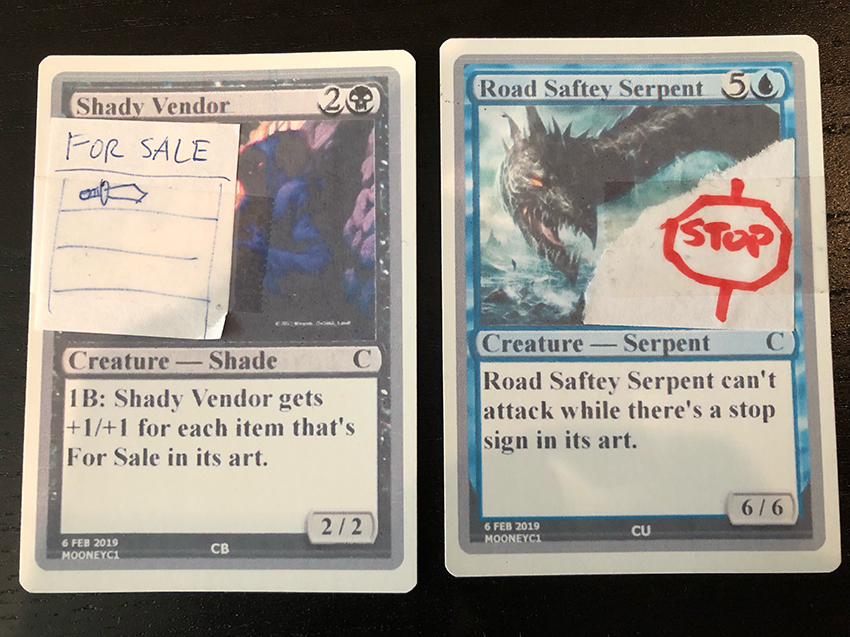
In the first version, you could tap to loot (draw a card and discard), but if you covered the cracks, you could just draw a card without having to discard. The second version gave a creature -2/-0 and then went up to -4/-0 when the cracks were covered. The third version was the one where you turned a creature into either a 4/4 Shark or an 8/8 Octopus depending on whether the cracks were covered.
The most challenging part of making this card came when we got to the art. In most sets, the art enhances the card, but it doesn't mechanically change how it works. With Astroquarium, the size of the cracks literally dictates how powerful the card is. This meant that I had to have numerous conversations with both Annie (Sardelis, who did the card concepting) and Dawn (Murin, who did the art directing) about how big exactly the crack was supposed to be. Be aware that the stickers weren't done yet, so we didn't know exactly how big those were going to be. We ended up making guesses at sticker sizes and then talked through how many stickers we thought would be needed to cover the cracks. In the end, we said two was the minimum, more likely three, but sometimes four plus if you got unlucky with your sticker sizes. This ended making a Y-shaped crack that went from the top to the bottom of the frame.
After the set had started printing, the printer sent us some booster display boxes to open and test. I opened an Astroquarium on my second pack and immediately started testing stickers on it. I was super happy that both it and Juggletron (the two cards that care about sticker size) ended up working out as originally envisioned. Here, by the way, is the art description for the card:
Setting: "Umbrella" (the set's codename)
Color: Blue artifact
Location: Merfolk marina p.29, inside one of the waterproof pods. Except this pod has a CRACK in its glass!
Action: Show a GLASS WALL of a large aquarium tank, with a SHARK and GIANT OCTOPUS behind it. The creatures wear bits of neon costuming or have natural neon patterning (see p.71 for similarly styled neon merfolk). There is a Y-SHAPED CRACK in the glass going from the top of the frame to the bottom (see attached reference). We see water dripping/spurting/leaking through the crack.
Focus: The crack in the glass
Mood: It's going to burst!
Notes: Please keep it to the one Y-shaped crack (no extra branches).
Done for the Day
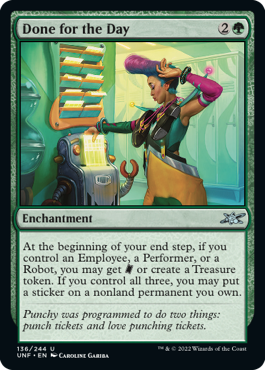
The evolution of this enchantment reveals a lot about the evolution of stickers and Attractions.
From over There (version #1)
3G
Enchantment
At the beginning of your upkeep, create a ticket token. (It's an artifact with {T}, Sacrifice this artifact: Add {C}. Spend this mana only on Attractions and stickers.)
{2G}, Sacrifice a ticket: Open the top card of your Attraction deck. Activate this ability only whenever you could cast a sorcery.
This design came from a time where tickets weren't counters but tokens. I believe this was at a point where we were trying mana as a gate for both stickers and Attractions, with the idea that tickets would be plentiful and would allow you to place stickers and visit Attractions, all while casting your normal spells. Note that mana was only the gate for visiting Attractions, evidenced the by fact that this card has an activated ability which opened Attractions.
From over There (version #2)
3G
Enchantment
At the beginning of your upkeep, you get one ticket.
Sacrifice CARDNAME: Prize 0. Activate this ability only whenever you could cast a sorcery. (You get no ticket counters but may buy a sticker from the prize wall.)
By this version, we stopped using tickets for Attractions and were limiting them to stickers. Instead of saying you could sticker a card, we were trying a keyword: prize.
Prize N meant you got N stickers and then could sticker a card. We ended up getting rid of prize, partly because it was more complicated than necessary, and partly because we wanted the ability to have cards that only stickered certain types of stickers.
From over There (version #3)
2G
Enchantment
Whenever a creature you control enters the battlefield, get a ticket.
Sacrifice CARDNAME: Prize 0. Activate this ability only whenever you could cast a sorcery. (You get no ticket counters but may buy a sticker from the prize wall.)
This design equated having creatures to getting tickets. There was a point in time where playtesters were putting all their stickers on just one creature, so we made some cards that pushed the sticker decks to want more creatures and encourage them to spread out their stickers.
From over There (version #4)
2G
Enchantment
Whenever a creature you control enters the battlefield, get {K}.
Sacrifice CARDNAME: Place a sticker on a permanent you own. (Pay any ticket cost with {K}.)
By this point, we started using the ticket icon. The printed version of this card ended up being a card that rewarded you for having Employees, Performers, and Robots. The set had introduced a bunch of creature types to represent the creatures working in the park, and I wanted at least one card to mechanically care about them (well, Employees and Performers; Robots had a whole archetype). The idea we latched onto was that this enchantment represented all the workers. I do like the subtle flavor that the workers chose between being paid with money (Treasure) or tickets for the park.
Embiggen

So, the set needed a common green pump spell. Usually that type of spell will boost a creature until end of turn between +2/+2 and +4/+4. As this was an Un- set, I wanted to find a variable to care about that would average in that range. It took a little searching, but I finally found one: words on the type line. Most creatures have the creature card type and then one to three creature subtypes. This worked perfectly. I made the card early in design, and it stayed untouched for a long time.
Flash forward to the conversation about Eternal versus acorn. While we had never counted supertypes, types, and subtypes on a card before, there was nothing about it that the rules couldn't handle. However, the problem came from play design. Most cards only have a handful of words on their type line, but there was one exception. The changeling mechanic (from Lorwyn) had every creature type. The mechanic has been used a few times and is on over 50 cards. Embiggen plus changeling meant enough damage to instantly kill any player in any format. That combination would mean having to make this an acorn card.
I asked, "What if I could tweak the card such that we avoided that combination?" The issue was that I had to do it in a way that didn't add a lot of words to the card. It would be better to have a clean acorn version of the card than a convoluted Eternal version. The design team was fine with this being an acorn card, but I had faith that there was a clean answer. After much thought, I found an answer that only involved adding one word to the template. If we targeted a non-[any creature type], then it would hit almost all creatures save Shapeshifters and that one named creature type. But what should that creature type be?
As this is an Un- set, my goal was to have it be the funniest option. What creature type could we reference that would make people smile when they read it even if they didn't understand right away why it was there? My first suggestion was Brushwagg.
Brushwagg had originally shown up in Mirage and had taken on a meme status among the Magic community as a silly one-of creature type, so much so, that we ended up making a second Brushwagg in Ikoria: Lair of Behemoths. We talked through many other options but kept coming back to Brushwagg until finally we gave up searching. Brushwagg it is! There's also a sticker that needed the same trick, so we used Brushwagg for that as well. Had this problem happened early enough that we could have made art for it, my gut says we would have put a Brushwagg in the set. And that is why Embiggen says "non-Brushwagg."
Get Your Head in the Game
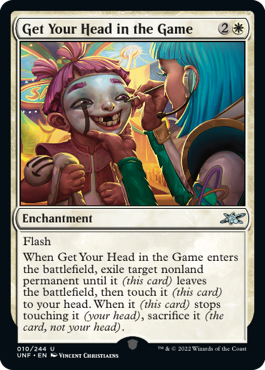
This card mostly stayed the same but went through one change that I want to talk about. Here's the earliest version:
Heads Up (version #1)
1W
Enchantment
Flash
When CARDNAME enters the battlefield, exile target creature until it leaves the battlefield. Then stick CARDNAME to your forehead. When it falls off, sacrifice it.
The intent of the original design was an Oblivion Ring variant, where you exiled the creature as long as the card stuck to your forehead. I've played card games all my life, and I learned as a kid how to stick a card to my forehead using the moisture on your forehead to hold the card in place. I assumed everyone knew how to do that. That is until we got to our first playtest with it.
I was playing against Chris Mooney, and they drew the card. They asked what it means to stick a card to your head. I demonstrated. Chris didn't understand how I was doing it. It turned out, they'd never seen anyone do that before nor had they ever done it. So, as far as Chris was concerned, the card said, "Do this thing you've never done and have no idea how to do."
We ended up changing it so that it only has to touch your head. This allowed players to stick it to their forehead if they wanted to, but they could also balance it on their head or hold it to their head. Simply put, it gives you more options.
Because this was a little easier, we upped it to 2W from 1W. Meanwhile, we were looking for more answers to other permanent types, so, as we were already raising the cost, we changed this card to exile any permanent rather than just a creature.
Gobsmacked
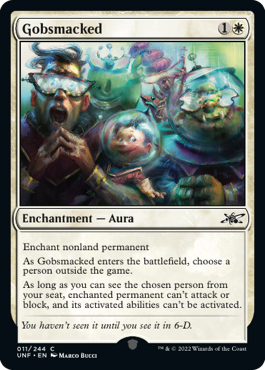
One of my goals with Unfinity was to bring back outside assistance, as it had proven a lot of fun in Unstable, but I was interested in expanding how it worked. We did a lot of brainstorming, and one idea that really stuck with me was an outside assistance card where the person helping you didn't even know that they were helping you. How exactly could we do that? It couldn't be something where you interacted with them, obviously.
This led to an idea of mine about the player having to see them. Why would that matter? What if an effect only worked while you could see them? If they, for some reason, went to another room, your effect would shut off. After a little thought, I realized an Arrest variant was the right mechanic to use for this effect.
In my first playtest with it, my opponent played a big creature on turn five, and I chose another person in the playtest (who was unaware that they'd been chosen). Two turns later, they left to go to the restroom. Now what? Would my whole game plan rely on surviving long enough for them to return? Other playtesters quickly learned what was going on, and it became a whole thing where everyone watched for that playtester to return. I finally saw them through the glass walking down the hall toward us just in time to save myself.
Times like these demonstrate how the right mechanic can create moments that enhance the experience and become stories players tell for the rest of their lives. When that happens, I know we have a success, and I do everything I can to make sure the card makes it into, and stays in, the set.
Nearby Planet
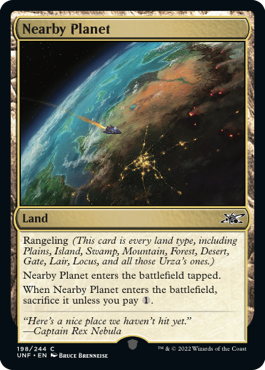
For this card, let me answer the questions everyone will be asking: Why is this an acorn card? Why couldn't it be an Eternal card? Technically, it doesn't work in the rules, but that's something that could have been addressed. Magic tweaks the rules all the time for new effects, and the change that this card would require to work wouldn't be a big deal.
The bigger problem was Legacy and Vintage. The reason we made some cards in the set Eternal is because that's the legality a set needs to be playable in Commander. Commander is our most casual format, and Un- sets are our most casual sets, so if we wanted to let any format play cards, we wanted it to be Commander. That meant, though, that we had to be cautious about what we were letting into Legacy and Vintage.
The team I put together to decide which cards were acorn and which were Eternal included Jess Dunks, the rules manager; Matt Tabak, the set's editor; myself, the lead set designer; and Carmen Handy from the Play Design team. It was Carmen's job to make sure we weren't making cards Eternal that would cause problems in Legacy or Vintage. Sometimes that means changing costs, and sometimes that means not making a card Eternal.
We created Nearby Planet because we needed a common land that tapped for all five colors to help fix mana in Limited (being all five basic land types does this). Rangeling, as I said above, technically didn't work in the rules, so it passed the bar for something an Un- set could do (back before the Eternal discussion happened). When the Eternal conversation came up, we had two choices: recost it so it wouldn't cause problems in Legacy and Vintage (which probably meant moving rarities) or make it an acorn card. The former would create numerous headaches (remember, the art had all been completed by this point) and would still be potentially dangerous, so we opted to make it an acorn card. Our guiding principle toward Legacy and Vintage had been "when it doubt, err toward safety," so we did.
Omniclown Colossus
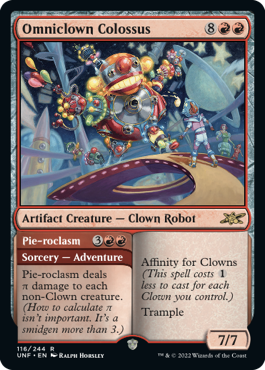
Omniclown Colossus and Pie-roclasm started as two separate spells. Unstable had a card called Just Desserts, which was the first card to ever use π damage.
The black-red faction in Unstable had originally been Clowns, and Just Desserts was the sole remnant of that design to make it to print. Had we only known the circus set was coming, we would have saved it.
We decided to do a riff on Just Desserts, and three different designers made the exact same card with the exact same name. That's how Pie-roclasm got added to the set. Omniclown Colossus had been designed by George Fan as a top-down card called Clown-Tron. Once George was aware that the Clowns in the set were all Robots, he got interested in the idea of a Voltron-like Clown. He dubbed it Clown-Tron, and here's his initial design:
Clown-Tron (version #1)
7
Legendary Artifact Creature — Giant Robot Clown
*/7
You may sacrifice three Clown creatures rather than pay CARDNAME's mana cost.
When CARDNAME enters the battlefield, roll three six-sided dice and put X +1/+1 counters on it, where X is the result.
If CARDNAME's power is:
15+ — CARDNAME has trample.
0-6 — CARDNAME has clownlink.
Prime — CARDNAME has flying. (Prime numbers include 2, 3, 5, 7, 11, 13, and 17)
The original Clown-Tron had a lot going on. You could sacrifice Clowns to get it out faster. There was dice rolling, +1/+1 counters, clownlink (a variant on Unstable's squirrellink), and "prime numbers matter."
The next versions cleaned things up a little.
Clown-Tron (version #2)
7
Legendary Artifact Creature — Giant Robot Clown
8/11
You may sacrifice five Clown creatures rather than pay this card's mana cost. If you do, CARDNAME gains haste until end of turn.
Menace
1, T: CARDNAME deals π damage to target creature.
Sacrifice a Clown: Untap CARDNAME.
When Clown-Tron dies, create five 1/1 colorless Artifact Robot Clown creature tokens.
This version still let you trade in Clowns to cast it but also gave you a way to use Clowns as a resource to deal damage. It upped the Clowns to five to capture the Voltron feeling, I assume. It also added in π damage. Finally, it gave you a death trigger, which gave you back the Clowns you may or may not have used to cast it.
We kind of knew that we couldn't have both Pie-roclasm and Clown-Tron, so in one meeting I told the team we had to pick one. Our decision was to combine them into a single card. Clown-Tron moved to red, and Pie-roclasm became an Adventure. It was a supplemental set, so we were allowed some one-of splashing of mechanics. To save space and make the card a bit better, sacrificing Clowns turned into affinity for Clowns. If you're going to splash non-evergreen mechanics, why stop at one?
The red-white archetype changed from "Clowns matter" to "Robots matter" late in design (there were three Robots that weren't Clowns and only one Clown that wasn't a Robot), but this card stayed affinity for Clowns as it fit the flavor so well and thus ended up the only "Clowns matter" card. Here's the art description for this card:
Setting: "Umbrella"
Color: Colorless artifact creature
Location: Parading through the streets of the Astrotorium (see pp 17–20 for inspiration). Maybe we see a glimpse of the interstellar expanse through the glass of the protective dome, or the massive roller coaster that rockets around the Astrotorium (pp 15, 21, 31).
Action: This is a GIANT CLOWN-BOT, made up of MULTIPLE SMALLER CLOWN-BOTS. It's kind of like a Transformer, and 20 FEET TALL. The PATTERNING on its body is a COLORFUL PATCHWORK from the many clown-bots it's made from, and we see MANY BRIGHT RED NOSES dotted all over its body. Maybe we are looking up at it from the street level.
Focus: The giant clown bot
Mood: Super cool or super terrifying, depending on who you ask
Notes: All clown bots have BOLD COLOR BLOCKING decorating their bodies and BRIGHTLY LIT RED NOSES (pp76–79).
"Storytime Is Over"
That's all the time I have for today. I hope you enjoyed hearing all the Unfinity card design stories. As always, I'm eager (and even more eager than normal) for any feedback on today's column, any of the cards I talked about, or about Unfinity itself. You can email me or contact me through my social media accounts (Twitter, Tumblr, Instagram, and TikTok) with feedback.
Join me next week for even more Unfinity card-by-card design stories.
Until then, may you have a chance to experience the fun of Unfinity for yourself.
#973: UNF Card Concepting with Annie Sardelis
#973: UNF Card Concepting with Annie Sardelis
31:31
I sit down with Annie Sardelis to talk about what card concepting is and how she did the card concepting for various cards in Unfinity.
#974: Unfinity Design, Part 2
#974: Unfinity Design, Part 2
30:40
This podcast is part two of a four-part series on the design of Unfinity.
- Episode 972 Unfinity Design, Part 1
- Episode 971 UNF Card Design with Chris Mooney
- Episode 970 Joel Mick

